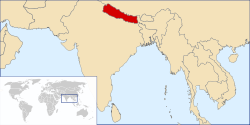Kingdom of Nepal
| Kingdom of Nepal | ||||||||||
|
||||||||||
|
||||||||||
|
||||||||||
|
||||||||||
|
Anthem Rastriya Gaan "May Glory Crown You, Courageous Sovereign" |
||||||||||
|
Territory of the Kingdom of Nepal in 2008
|
||||||||||
| Capital | Kathmandu | |||||||||
| Languages | Nepali (Gorkhali) | |||||||||
| Religion | Hinduism | |||||||||
| Government |
|
|||||||||
| Mahārājādhirāja | ||||||||||
| • | 1768–1775 | Prithvi Narayan Shah (first) | ||||||||
| • | 2001–2008 | Gyanendra Bir Bikram Shah Dev (last) | ||||||||
| Prime Minister | ||||||||||
| • | 1846–1856 | Bhimsen Thapa (first) | ||||||||
| • | 2006–2008 | Girija Prasad Koirala (last) | ||||||||
| Legislature |
|
|||||||||
| History | ||||||||||
| • | Unification under Prithvi Narayan Shah | 25 September 1768 | ||||||||
| • | Rana dynasty | 1846–1953 | ||||||||
| • | Shah dynasty | 1951–2007 | ||||||||
| • | Constitutional monarchy | 1990–2007 | ||||||||
| • | Republic | 28 May 2008 | ||||||||
| Currency |
|
|||||||||
|
||||||||||
| Today part of |
|
|||||||||
The Kingdom of Nepal (Nepali: नेपाल अधिराज्य), also known as the Kingdom of Gorkha (Nepali: गोर्खा अधिराज्य), was a kingdom formed in 1768 by the unification of Nepal. Founded by King Prithvi Narayan Shah, a Gorkhali monarch of Rajput origin, it existed for 240 years until the abolition of the Nepalese monarchy in 2008. During this period, Nepal was formally under the rule of the Shah dynasty, which exercised varying degrees of power during the kingdom's existence.
Despite a humiliating defeat to China after a failed invasion of Tibet in the 1790s, which led to Nepal becoming a tributary state of the Chinese Empire, Nepal successfully consolidated its territories in the ensuing years. During the early-nineteenth century, however, the expansion of the East India Company's rule in India led to the Anglo-Nepalese War (1814–1816), which resulted in Nepal's defeat. Under the Sugauli Treaty, the kingdom retained its independence, but became a de facto protectorate of Britain in exchange for territorial concessions equating to a third of the territory then under Nepalese rule, sometimes known as "Greater Nepal". Political instability following the war resulted in the ascendancy of the Rana dynasty of Khas Chhetri Rajput origin, which made the office of Prime Ministers of Nepal hereditary in their family for the next century, from 1843 to 1951. Beginning with Jung Bahadur, the first Rana ruler, the Rana dynasty reduced the Shah monarch to a figurehead role. Rana rule was marked by tyranny, debauchery, economic exploitation and religious persecution.
...
Wikipedia



